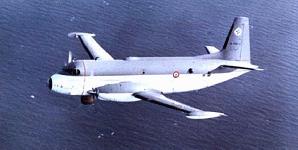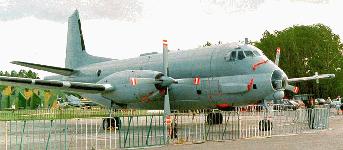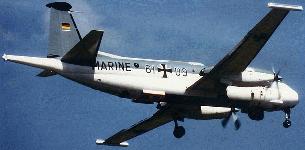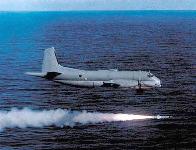FAS |
Military |
DOD 101 |
Systems |
Aircraft |
ROW ||||
Index |
Search |
Join FAS




Br 1150 Atlantique
Maritime Patrol Aircraft (MPA 2000)
The Dassault-Breguet Atlantique is the long-range reconnaissance aircraft of the French Navy. This long-range naval patrol aircraft is a European collaboration, built under the supervision of Dassault Aviation. The Atlantique is the standard sea reconnaissance aircraft and sub hunter in many NATO countries. It is fitted with antiship-missiles, ASW-weapons, sonar buoys and a magnetic anomaly detector [MAD].
Atlantic 1
The Atlantic is an aircraft with a take-off weight of 43.5 metric tons, powered by two Tyne turboprop 5,500 hp engines. Its 12-man crew conducts missions that can last up to 18 hours over flight distances of approximately 8,000 km, covered at a maximum speed of 650 km/h. On 14th December 1956, the members of the NATO Council stipulated that, as a successor to the American aircraft Lockheed P 2V-7 Neptune, they needed a long-range maritime reconnaissance and antisubmarine warplane. On 30th January 1959, the NATO Armaments Committee unanimously selected, out of the 21 projects presented, the Breguet Br 1150 Atlantic program. This aircraft is remarkable for being the only maritime patrol aeroplane in the world specially designed for its mission and not just a derivative of a commercial civil aircraft. Manufacturing work was divided between the four participating countries:- Breguet and Sud-Aviation in France;
- Fokker in the Netherlands;
- Dornier and Siebel in West Germany;
- SABCA, Fairey et Fabrique Nationale (FN) Herstal in Belgium.
Atlantic 2
The Atlantic 2 long range maritime patrol aircraft, specifically designed for anti-submarine warfare (ASW) and anti-surface warfare (ASUW), is derived from the NATO Atlantic Mk 1 (ATL 1). This new variant of the Atlantique family aimed at all international, and especially European, programs for the acquisition or replacement of naval patrol airfleets. It features advanced sensors (Radar, ESM, Acoustic, FLIR and MAD), supported by a distributed data processing system architecture (redundant mutiplex data bus, digital computer, multipurpose displays). A total of 28 ATL 2s have been ordered for the French Navy; 23 of these were in service as of 1999.Atlantic 3
Updated manufacture of new aircraft integrates the latest technology both in platform design and in weapons systems: the ATLANTIC 3.Maritime Patrol Aircraft (MPA 2000)
The Maritime Reconnaissance Aircraft BR 1150 Atlantic is in service with the German and Italian armed forces since several years. According to plans of the German and Italian ministries of defense, this type of aircraft is to be replaced by a modern aircraft by the year 2007. Dasa's Military Aircraft Business Unit, which has been proposed as the German systems leader, is on talks with Alenia Aerospazio, the proposed Italian systems leader. The MoU is to harmonize concepts of both companies for a possible mission equipment. Additionally both companies will share their experiences in definition, integration, and maintenance of the MPA 2000 aircraft. Besides a re-design of the aircraft, a major role plays the the realization of a modern mission equipment. Core element is to be the so-called Tactical Command System (TCS). TCS bases on most modern computer technology. It eases the work of the on-board specialists by automatization of the sensor control and surveillance and increases the mission efficiency of the whole reconnaissance system and its flexibility in the face of changing situation by a modern, ergonomic man-machine-interface. TCS is supported by a stationary ground system, the Maritime Air Operations Center, as well as its transportable version, the Transportable Air Operations Center. Both systems are part of the planning, surveying and evaluating process of a mission as well as the interpretation of retrieved information in order to form a situation synopsis.Specifications | |
| Country of Origin | |
|
In-service in the French Navy : |
1989 |
| Builder | Dassault-Breguet |
| Role | naval patrol |
| Similar Aircraft | |
|
Major operational capabilities : |
Working out of the surface and underwater tactical situation Support to the strategic ocean force Support to a maritime force in operation Security of the operation zones |
| Wing Span | 119' / 36,3 m |
| Length | 104' |
| Height | 37' |
|
Weight : empty / maximum at takeoff : |
25 t / 46.5 t |
|
Fuel capacity : |
16 t |
| Engine | 2 TYNE MK 21 Turboprop engines 5,500 hp each / ( 6106 hp each) 12212 hp |
| Maximum speed | 355 kts (650 km/h) |
| Cruising speed | 315 Kn (580 km/h) |
| Range |
8 hours on station at 600 NM with standard armament 18 hours - maximum flight time 4200-4859 NM - maximum range |
| Service Ceiling | 33,000 ft [39,300 ft ?] |
|
Crew : |
2 pilots, 1 aircraft commander, 2 observers, 1 navigator, 1 radio operator, 1 electronic warfare operator, 1 computer scientist, 1 tactical co-ordinator, 3 anti-submarine detection operators |
|
Special equipments : |
Digital bus �digibus�, Iguane radar, Crouzet DHAX3 magnetic anomaly detector, forward-looking infrared system, Tango thermal camera, acoustic detection and analysis system, Arar 13radar detector and analyser, photographic equipment, GPS receiver, 2 inertial navigation systems |
| Armament |
|
|
NATO interoperability : |
Protected radiocommunication, identification friend or foe, �link 11� data transmission |
| Crew | 12 |
| Cost | |
| User Countries | |
|
French Navy inventory : |
28 aircraft in 2 squadrons |





Sources and Resources
FAS |
Military |
DOD 101 |
Systems |
Aircraft |
ROW ||||
Index |
Search |
Join FAS
http://www.fas.org/man/dod-101/sys/ac/row/atlantique.htm
Maintained by Robert Sherman
Originally created by John Pike
Updated Monday, November 15, 1999 5:25:38 AM